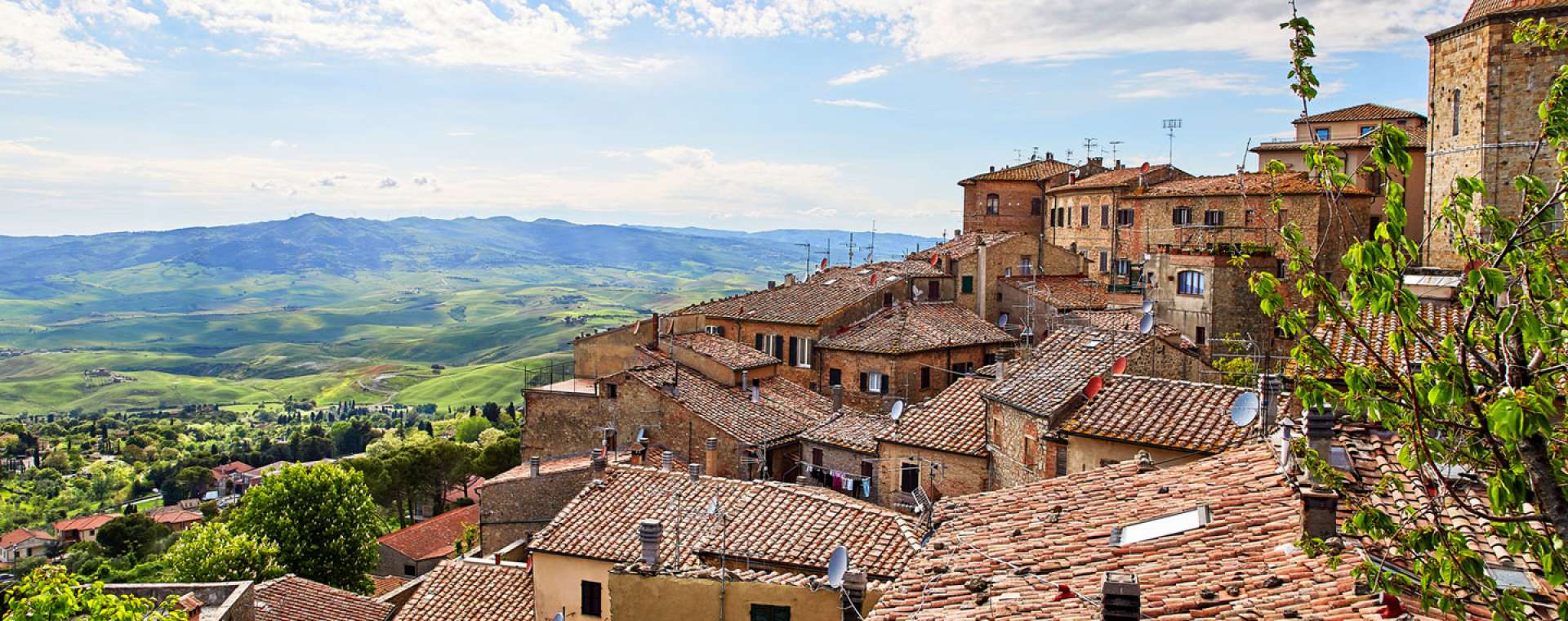Volterra travel guide
Volterra is another handsome medieval Tuscan hill-town where the glory days are a distant memory. In Volterra’s case, very distant: the “city” known as Velathri reached its peak when the (pre-Roman) Etruscans were calling the shots in Tuscany. In the 1st century BC, Volterra’s walls enclosed an area almost twice as large as today’s atmospheric little town.
Most of the surviving architecture dates to the medieval period, especially around Piazza dei Priori and the warren of narrow, shadowy streets that surround it.
In the Beginning...
This was once a large and powerful Etruscan city. “Velathri” was far bigger than the small, steep, stone Volterra — and an important member of the Etruscan Dodecapoli (twelve-member alliance). At the far edge of town are Le Balze, a clay area that once stood inside the Etruscan city walls, but which has collapsed over centuries of erosion. The precipices are frightening — and slowly advancing towards the modern town.
Memories of the Etruscan era remain in an excellent archaeological collection and traditional alabaster craftsmanship, which is still practised in small workshops around the centre. The writer D. H. Lawrence was fascinated by the Etruscans, and visited Volterra several times in the 1920s.
Like nearby San Gimignano, the current town is mostly a relic of the medieval building boom. It also has Tuscany’s oldest town hall. The Gothic Palazzo dei Priori was completed in 1257, and became the model for Florence’s Palazzo Vecchio, built half a century later. It still hosts meetings of Volterra’s town council.
Visit This
In Piazza San Giovanni, a Pisan-style Cathedral faces Volterra’s octagonal Baptistery. Its Renaissance baptismal font is by Sansovino, a Tuscan native from Monte San Savino.
Downhill from the main square, close to the medieval Porta San Francesco, the church of San Francesco has a chapel frescoed (like Piero della Francesca’s in Arezzo) with panels that narrate the “Legend of the True Cross”, painted in 1410.
The outstanding Pinacoteca Civica’s art collection is arranged in a historical timeline, and includes panels by Taddeo di Bartolo, Domenico Ghirlandaio, Luca Signorelli (a decorative “Annunciation”), and several others.
The standout is Rosso Fiorentino’s giant “Deposition”, painted in 1521. It is a genuine classic of the Mannerist painting genre, full of contorted, discoloured bodies and raw emotion.
Volterra also houses one of Tuscany’s most impressive Etruscan museums. The Museo Etrusco Guarnacci has exhibits over a couple of floors, including racks of cinerary urns; the Etruscans practised cremation and kept ashes in ornate alabaster or terracotta vases. Prize exhibit here is the “Ombra della sera”, a mysterious, elongated bronze figurine of a boy that was probably used in worship.
More recently Volterra gained a dose of modern international fame as the fictional home of the “Volturi”, from Stephanie Meyer’s “Twilight” series of vampire books and films. However, the “Volterra” scenes in the “Twilight: New Moon” movie were actually shot in Montepulciano.
From the tower of the 13th-century Palazzo dei Priori is a fine view over the rooftops and the rolling Valdicecina countryside beyond.
Volterra is the fictional home of the “Volturi”, from Stephanie Meyer’s “Twilight” series of vampire books and films
Eat This
Enoteca del Duca has been the top of the fine-dining tree in central Volterra for over a decade. Its longevity is in part thanks to a rep founded on local ingredients, whether fish landed daily at Cecina or mushrooms foraged in nearby woods. It is a proper ristorante, in an elegant old palazzo with an atmosphere that’s friendly rather than stuffy. The wine list includes Giusto alle Balze, award-winning wines made on the family farm just outside of town.
There is almost nothing in the tiny hamlet of Mazzolla except a stone church, a few parking spaces and the small restaurant with a covered veranda, Albana. The short, simple menu is big on local, historical specialities, such as ravioli stuffed with guinea fowl, leeks, and almonds.
Eagle-eyed travellers might spot that Steve Coogan and Rob Brydon ate at Albana in the BBC’s “Trip to Italy”.
Buy This: Alabaster in Volterra
Volterra has been a centre for alabaster workmanship for millennia — another Etruscan legacy. Several open workshops remain in the backstreets, including alab’Arte, where you can admire pieces in various states of completion. The whole place is shrouded in a film of white alabaster dust.
Gloria Giannelli is another local artisan who works with the delicate, ghostly-white calcium carbonate; her creations have a contemporary edge.
The craft co-operative, the Società Cooperativa Artiero Alabastro, sells hand-made alabaster items made by local artisans from a shop in Volterra’s main square.
Festivals
Volterra has a particularly eerie and atmospheric Good Friday procession, with torches, lanterns and solemn, hooded penitents.
Three Excursions from Volterra
- San Gimignano: for a preserved medieval town, with hidden alleys, Gothic towers and fine frescoes
- Pisa: more than just an iconic Leaning Tower, Pisa’s has a square of architectural miracles, handsome Renaissance palaces stretched along the banks of the River Arno and a lively student population
- San Miniato: this lofty hill-town high above the Arno valley has ancient Holy Roman history and a well-earned rep for its artichokes and white truffles
